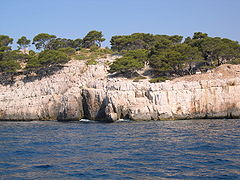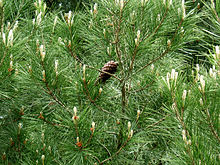| Revision as of 09:18, 19 July 2007 editSmackBot (talk | contribs)3,734,324 editsm Date/fix the maintenance tags or gen fixes← Previous edit | Revision as of 23:56, 6 October 2007 edit undo84.48.54.109 (talk)No edit summaryNext edit → | ||
| Line 31: | Line 31: | ||
| ===In art=== | ===In art=== | ||
| ] had an Aleppo Pine in his garden at ]; this tree was the inspiration and model for his painting, ''The Big Trees''. As of 2005, the tree is still blossoming in Cézanne's garden. | ] had an Aleppo Pine in his garden at ]; this tree was the inspiration and model for his painting, ''The Big Trees''. As of 2005, the tree is still blossoming in Cézanne's garden. | ||
| ===Worth noting=== | |||
| This tree specie is the most CO2 effective tree in the world, absorbing 48 tonnes of CO2 in average each year. | |||
| ==References== | ==References== | ||
| Line 37: | Line 39: | ||
| *Cézanne, P. ''Visions''. In ''Architectural Digest'' December 2005: 117. | *Cézanne, P. ''Visions''. In ''Architectural Digest'' December 2005: 117. | ||
| {{commons|Pinus halepensis}} | {{commons|Pinus halepensis}} | ||
| * | |||
| ] | ] | ||
Revision as of 23:56, 6 October 2007
| Aleppo Pine | |
|---|---|

| |
| Aleppo Pines at Calanques near Marseille, France | |
| Conservation status | |
 Least Concern | |
| Scientific classification | |
| Kingdom: | Plantae |
| Division: | Pinophyta |
| Class: | Pinopsida |
| Order: | Pinales |
| Family: | Pinaceae |
| Genus: | Pinus |
| Subgenus: | Pinus |
| Species: | P. halepensis |
| Binomial name | |
| Pinus halepensis Miller | |
The Aleppo Pine (Pinus halepensis) is a pine native to the Mediterranean region. The range extends from Morocco and Spain north to southern France, Italy and Croatia, and east to Greece and northern Libya, with an outlying population (from which it was first described) in Syria (including Aleppo), Jordan and Israel. It is generally found at low altitudes, mostly from sea level to 200 m, but can grow at an altitude of up to 1000 m in southern Spain, and up to 1700 m in the south, in Morocco and Algeria.

It is a small to medium-size tree, reaching 15-25 m tall and with a trunk diameter of up to 60 cm, and in exceptional cases even up to 1 m. The bark is orange-red, thick and deeply fissured at the base of the trunk, and thin and flaky in the upper crown. The leaves, or "needles", are very slender - mostly 6-10 cm long, distinctly yellowish green and almost always come in pairs. The cones are narrow conic, 5-10 cm long and 2-3 cm broad at the base when closed, green at first, ripening glossy red-brown when 24 months old. They open slowly over the next few years, a process which is quickened when they are exposed to heat such as the case is in forest fires. The cones open 5-8 cm wide to allow the seeds, which are stored in them, come out and plant themselves. The seeds themselves are 5-6 mm long, with a 20 mm wing, and are wind-dispersed.

Aleppo Pine is closely related to the Turkish Pine, Canary Island Pine and Maritime Pine which all share many of its characteristics. Some authors include the Turkish Pine as a subspecies of the Aleppo Pine, but it is usually regarded as a distinct species. It is a relatively non-variable species, with its morphological characteristics staying constant over the entire range.
It is widely planted for timber in its native area, being one of the most important trees in forestry in Algeria and Morocco. It is also a popular ornamental tree, extensively planted in parks and gardens in hot dry areas such as Southern California, where its considerable heat and drought tolerance is highly valued.
In art
Paul Cézanne had an Aleppo Pine in his garden at Aix-en-Provence; this tree was the inspiration and model for his painting, The Big Trees. As of 2005, the tree is still blossoming in Cézanne's garden.
Worth noting
This tree specie is the most CO2 effective tree in the world, absorbing 48 tonnes of CO2 in average each year.
References
- Template:IUCN2006
- Gymnosperm Database: Pinus halepensis
- Cézanne, P. Visions. In Architectural Digest December 2005: 117.